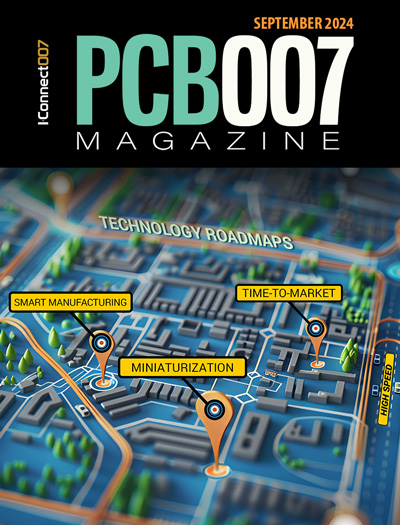-

- News
- Books
Featured Books
- pcb007 Magazine
Latest Issues
Current Issue
Engineering Economics
The real cost to manufacture a PCB encompasses everything that goes into making the product: the materials and other value-added supplies, machine and personnel costs, and most importantly, your quality. A hard look at real costs seems wholly appropriate.

Alternate Metallization Processes
Traditional electroless copper and electroless copper immersion gold have been primary PCB plating methods for decades. But alternative plating metals and processes have been introduced over the past few years as miniaturization and advanced packaging continue to develop.

Technology Roadmaps
In this issue of PCB007 Magazine, we discuss technology roadmaps and what they mean for our businesses, providing context to the all-important question: What is my company’s technology roadmap?
- Articles
- Columns
Search Console
- Links
- Media kit
||| MENU - pcb007 Magazine
Self-Stacking Nanogrids
January 22, 2016 | MITEstimated reading time: 4 minutes
Polymers are long molecules made from basic molecular units strung into chains. Plastics are polymers, and so are biological molecules like DNA and proteins. A copolymer is a polymer made by joining two different polymers.
In a block copolymer, the constituent polymers are chosen so that they’re chemically incompatible with each other. It’s their attempts to push away from each other — both within a single polymer chain and within a polymer film — that causes them to self-organize.
In the MIT researchers’ case, one of the constituent polymers is carbon-based, the other silicon-based. In their efforts to escape the carbon-based polymer, the silicon-based polymers fold in on themselves, forming cylinders with loops of silicon-based polymer on the inside and the other polymer bristling on the outside. When the cylinders are exposed to an oxygen plasma, the carbon-based polymer burns away and the silicon oxidizes, leaving glass-like cylinders attached to a base.
To assemble a second layer of cylinders, the researchers simply repeat the process, albeit using copolymers with slightly different chain lengths. The cylinders in the new layer naturally orient themselves perpendicularly to those in the first.
Chemically treating the surface on which the first group of cylinders are formed will cause them to line up in parallel rows. In that case, the second layer of cylinders will also form parallel rows, perpendicular to those in the first.
But if the cylinders in the bottom layer are allowed to form haphazardly, snaking out into elaborate, looping patterns, the cylinders in the second layer will maintain their relative orientation, creating their own elaborate, but perpendicular, patterns.
The orderly mesh structure is the one that has the most obvious applications, but the disorderly one is perhaps the more impressive technical feat. “That’s the one the materials scientists are excited about,” Nicaise says.
Page 2 of 3
Suggested Items
CHIPS for America Announces Up to $300M in Funding to Boost U.S. Semiconductor Packaging
11/21/2024 | U.S. Chamber of CommerceThe Biden-Harris Administration announced that the U.S. Department of Commerce (DOC) is entering negotiations to invest up to $300 million in advanced packaging research projects in Georgia, California, and Arizona to accelerate the development of cutting-edge technologies essential to the semiconductor industry.
Global Citizenship: What I’ve Learned About the American PCB Business
11/20/2024 | Tom Yang -- Column: Global CitizenshipNavigating the complexities of the American PCB business has been an eye-opening experience. During my time in America, I have become more familiar with the American PCB business and doing business here. If I may, and with your indulgence, I would like to share my humble impressions of the American PCB industry and the American way of doing business, which I find interesting and admirable.
Spirit Announces Purchase Agreement with Tex Tech Industries for Intended Sale of FMI
11/19/2024 | Spirit AeroSystems, Inc.Spirit AeroSystems Holdings, Inc. announces a purchase agreement to sell Fiber Materials, Inc (FMI) business based in Biddeford, Maine, and Woonsocket, Rhode Island, to Tex-Tech Industries, Inc. for $165,000,000 in cash, subject to customary adjustment.
Ventec to Become Primary PCB Materials Supplier for Teltonika
11/13/2024 | VentecVentec International Group and high-tech design and manufacturing company Teltonika announce that Ventec is to become supply chain partner and primary supplier of PCB base materials to Teltonika, which is preparing to open a new PCB manufacturing plant at its base in Vilnius, Lithuania.
AIM to Present on Micro/MiniLED Applications at Hangjia Talk in Shenzhen, China
11/11/2024 | AIM SolderAIM Solder, a leading global manufacturer of solder assembly materials for the electronics industry, is pleased to announce its participation in the upcoming Hangjia annual industry event focused on the future of the LED display sector.


